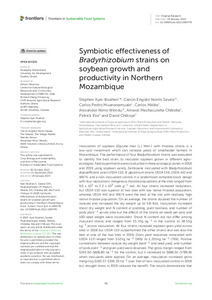| dc.contributor.author | Boahen, S. |
| dc.contributor.author | Engoke, C. |
| dc.contributor.author | Muananamuale, C. |
| dc.contributor.author | Malita, C. |
| dc.contributor.author | Wiredu, A. |
| dc.contributor.author | Chibeba, A.M. |
| dc.contributor.author | Elia, P. |
| dc.contributor.author | Chikoye, D. |
| dc.date.accessioned | 2023-10-11T14:47:20Z |
| dc.date.available | 2023-10-11T14:47:20Z |
| dc.date.issued | 2023-01-18 |
| dc.identifier.citation | Boahen, S., Engoke, C., Muananamuale, C., Malita, C., Wiredu, A., Chibeba, A.M., ... & Chikoye, D. (2023). Symbiotic effectiveness of Bradyrhizobium strains on soybean growth and productivity in Northern Mozambique. Frontiers in Sustainable Food Systems, 6: 1084745, 1-15. |
| dc.identifier.issn | 2571-581X |
| dc.identifier.uri | https://hdl.handle.net/20.500.12478/8274 |
| dc.description.abstract | Inoculation of soybean [Glycine max (L.) Merr.] with rhizobia strains is a low-cost investment which can increase yields of smallholder farmers in Mozambique. The performance of four Bradyrhizobium strains was evaluated to identify the best strain to inoculate soybean grown in different agro-ecologies. Field experiments were conducted in three ecological zones in 2018 and 2019 using soybean variety Zamboane inoculated with Bradyrhizobium diazoefficiens strain USDA 110, B. japonicum strains USDA 136, USDA 442 and WB74, and a non-inoculated control in a randomized complete block design with four replications. Indigenous rhizobia populations at the sites ranged from 9.0 x 101 to 2.2 x 103 cells g−1 soil. All four strains increased nodulation, but USDA 110 was superior at two sites with low native rhizobia population, whereas USDA 442 and WB74 were the best at the site with relatively high native rhizobia population. On an average, the strains doubled the number of nodules and increased the dry weight up to 5.8-fold. Inoculation increased shoot dry weight and N content at podding, plant biomass, and number of pods plant−1 across sites but the effects of the strains on seeds per pod, and 100-seed weight were inconsistent. Shoot N content did not differ among inoculant strains and ranged from 15.70 g kg−1 in the control to 38.53 g kg−1 across inoculation. All four strains increased soybean grain yield across sites in 2018 but USDA 110 outperformed the other strains and was also the best at one of the two sites in 2019. Grain yield responses associated with USDA 110 ranged from 552 kg ha−1 (56%) to 1,255 kg ha−1 (76%). Positive correlations between nodule dry weight plant−1 and seed yield, and number of pods plant−1 and grain yield were observed. The gross margin ranged from $343.50–$606.80 ha−1 for the control, but it increased to $688.34–$789.36 when inoculants were applied. On an average, inoculation increased gross margin by $182.57-$395.35 ha−1 over that of non-inoculated control in 2018 but drought stress in 2019 reduced the benefit. The results demonstrate that USDA 110 was the best inoculant strain and has the potential of increasing smallholder productivity and net returns. |
| dc.description.sponsorship | United States Agency for International Development |
| dc.format.extent | 1-15 |
| dc.language.iso | en |
| dc.subject | Soybeans |
| dc.subject | Grain Legumes |
| dc.subject | Varieties |
| dc.subject | Smallholders |
| dc.subject | Farmers |
| dc.subject | Food Security |
| dc.subject | Mozambique |
| dc.title | Symbiotic effectiveness of Bradyrhizobium strains on soybean growth and productivity in Northern Mozambique |
| dc.type | Journal Article |
| cg.contributor.crp | Grain Legumes |
| cg.contributor.affiliation | International Institute of Tropical Agriculture |
| cg.contributor.affiliation | United States Department of Agriculture-Agricultural Research Service |
| cg.coverage.region | Africa |
| cg.coverage.region | Southern Africa |
| cg.coverage.country | Mozambique |
| cg.coverage.hub | Southern Africa Hub |
| cg.researchtheme | Natural Resource Management |
| cg.researchtheme | Plant Production and Health |
| cg.researchtheme | Social Science and Agribusiness |
| cg.identifier.bibtexciteid | BOAHEN:2023 |
| cg.isijournal | ISI Journal |
| cg.authorship.types | CGIAR and advanced research institute |
| cg.iitasubject | Agronomy |
| cg.iitasubject | Crop Systems |
| cg.iitasubject | Food Security |
| cg.iitasubject | Grain Legumes |
| cg.iitasubject | Plant Breeding |
| cg.iitasubject | Plant Production |
| cg.iitasubject | Smallholder Farmers |
| cg.iitasubject | Soybean |
| cg.journal | Frontiers in Sustainable Food Systems |
| cg.notes | Open Access Journal; Published online: 18 Jan 2023 |
| cg.accessibilitystatus | Open Access |
| cg.reviewstatus | Peer Review |
| cg.usagerightslicense | Creative Commons Attribution 4.0 (CC BY 0.0) |
| cg.targetaudience | Scientists |
| cg.identifier.doi | https://doi.org/10.3389/fsufs.2022.1084745 |
| cg.iitaauthor.identifier | Stephen Boahen Asabere: 0000-0001-8946-401X |
| cg.iitaauthor.identifier | Canon Norris Savala Engoke: 0000-0002-9667-2324 |
| cg.iitaauthor.identifier | Alexander Nimo Wiredu: 0000-0002-8487-4340 |
| cg.iitaauthor.identifier | Amaral Machaculeha Chibeba: 0000-0001-6019-4482 |
| cg.iitaauthor.identifier | David Chikoye: 0000-0002-6047-9821 |
| cg.futureupdate.required | No |
| cg.identifier.issue | 1084745 |
| cg.identifier.volume | 6 |

